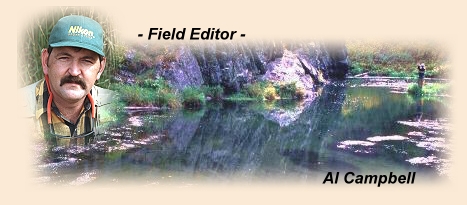
| ||
|
April 26th, 2004
Basic Magic Baetis Mayfly |
|
 It consists of three tables, two clamps and three grooved dowels. You'll see a table and clamp used in this article, and future articles. The dowels are for wrapping long materials like Crystal Flash around them so the material can be trimmed to an exact length. You just wrap the material and trim it by cutting it with a razor or fine point scissors. The grooves serve as a guide for scissor points or a razor.
Materials Basic Magic Baetis Mayfly:
Tying steps: 1. Start the thread.
 2. Add a tail of dark dun hackle fibers.
 3. Tie a CDC feather in by the tip using one or two loose wraps.
|

 5. Now twist the feather until it forms a type of rope or thread.
 6. Wrap the body forward keeping the CDC feather twisted as you go. I'm using a Peak rotary vise, so this is easy to do. It isn't hard if you use a regular vise either. Just keep the CDC twisted as you wrap.
|

 8. Trim the CDC feather stem and the loose CDC fibers around the body.
 9. Now, take two or three CDC feathers and lay them on top of one of the tables as shown. I'm using the middle-sized table here, but the size of your fly will dictate what size table you will need to use.
|

 11. And, push them down into the table as shown.
 12. Trim the ends of the CDC feathers at the edge of the table.
|

14. Now, squeeze the table open and remove the
feathers that are secured in the clamp. You
should be able to plainly see the stems of
the feathers.
15. Trim the feather stems off with your scissors.
Set the clamp aside for later use.
|

17. Keep the thread spread apart while you insert
the CDC in the clamp between the thread.
18. Next, twist the thread so that the CDC fibers
spin. You should be able to do this by spinning
the bobbin.
|

20. As you wrap the CDC hackle, pull it backward
and upward so that most of the fibers end up on
top of the hook.
21. Your fly will look fairly unruly when you
get to the end of the hackle wrapping.
|

23. Whip finish and trim the thread.
24. Trim the loose fibers on the bottom of the fly.
|
 26. Clean up any loose fibers. I leave the fly a little ragged because the extra CDC just adds to the flotation abilities of the fly.
 27. Your finished fly should look somewhat like this.
|
[ HOME ]
[ Search ] [ Contact FAOL ] [ Media Kit ]









